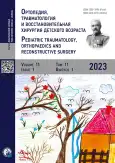Footprint analysis in flatfoot assessment
- Authors: Sapogovskiy A.V.1, Ovechkina A.V.1, Abramov I.A.2, Agranovich O.E.1, Shubina A.I.1, Budkevich T.G.3
-
Affiliations:
- H. Turner National Medical Research Center for Children’s Orthopedics and Trauma Surgery
- Murmansk Regional Clinical Multidisciplinary Center
- Boarding school No. 49 of St. Petersburg’s Petrodvortsovy district “School of Health”
- Issue: Vol 11, No 1 (2023)
- Pages: 67-74
- Section: Clinical studies
- URL: https://journal-vniispk.ru/turner/article/view/254924
- DOI: https://doi.org/10.17816/PTORS121335
- ID: 254924
Cite item
Abstract
BACKGROUND: A flatfoot is the most common condition in the practice of a pediatric orthopedist. A flatfoot is primarily diagnosed based on the assessment of the degree of the foot flattening. Along with clinical examination, footprint analysis is often used in practice due to the safety of this study and convenience and ease of implementation.
AIM: This study aimed to determine how much footprints can correlate with the clinical assessment of flatfoot in children and which footprint indices are the most valuable in flatfoot assessment.
MATERIALS AND METHODS: The study included the survey results of 76 children aged 7–15 years of the St. Petersburg 49th school “School of Health” for 2021–2022. In this study, anthropometric data, clinical parameters (value of the heel valgus, arch angle, and Friedland index) and footprint indices and angles (Schwartz and Clarke angle, Chippaux–Smirak index, Staheli index, Cavanagh and Rodgers index, and Irwin index) were analyzed. In the study, the average values were calculated, and correlation and regression analyses were performed.
RESULTS: The footprint parameters did not have moderate and strong correlations with clinical parameters. Footprint parameters that assessed the area of the barefoot zone on the footprints (Irwin index and Cavanagh and Rodgers index) showed statistically significant moderate and strong correlations among plantographic parameters. Among linear and angular footprint parameters, the Chippaux–Smirak index showed statistically significant moderate and strong correlations.
CONCLUSIONS: The footprint criteria weakly correlated with the foot shape criteria in a clinical assessment, which does not allow us to interpolate the footprint’s data to the clinical evaluation data of the foot. The Cavanagh and Rodgers index, Irwin index, and Chippaux–Smirak index had statistically significant moderate and strong correlations with other indices, which makes them more valuable in the assessment of feet according to the footprint analysis.
Full Text
##article.viewOnOriginalSite##About the authors
Andrey V. Sapogovskiy
H. Turner National Medical Research Center for Children’s Orthopedics and Trauma Surgery
Email: sapogovskiy@gmail.com
ORCID iD: 0000-0002-5762-4477
SPIN-code: 2068-2102
Scopus Author ID: 57193257532
MD, PhD, Cand. Sci. (Med.)
Russian Federation, Saint PetersburgAlla V. Ovechkina
H. Turner National Medical Research Center for Children’s Orthopedics and Trauma Surgery
Email: ovechkina.spb@mail.ru
ORCID iD: 0000-0002-3172-0065
SPIN-code: 7049-6674
Scopus Author ID: 6507566283
MD, PhD, Cand. Sci. (Med.), Assistant Professor, Honored Doctor of the Russian Federation
Russian Federation, Saint PetersburgIlya A. Abramov
Murmansk Regional Clinical Multidisciplinary Center
Email: ia.murman@yandex.ru
ORCID iD: 0000-0003-4653-4203
MD, Paediatric Orthopaedic Surgeon
Russian Federation, MurmanskOlga E. Agranovich
H. Turner National Medical Research Center for Children’s Orthopedics and Trauma Surgery
Email: olga_agranovich@yahoo.com
ORCID iD: 0000-0002-6655-4108
SPIN-code: 4393-3694
Scopus Author ID: 56913386600
ResearcherId: B-3334-2019
MD, PhD, Dr. Sci. (Med.)
Russian Federation, Saint PetersburgAnastasia I. Shubina
H. Turner National Medical Research Center for Children’s Orthopedics and Trauma Surgery
Email: shubinaasia@gmail.com
ORCID iD: 0000-0001-7843-9564
MD, PhD student
Russian Federation, Saint PetersburgTatyana G. Budkevich
Boarding school No. 49 of St. Petersburg’s Petrodvortsovy district “School of Health”
Author for correspondence.
Email: Bt-tata@mail.ru
ORCID iD: 0000-0002-4278-5454
MD, PhD, Cand. Sci. (Med.)
Russian Federation, Saint PetersburgReferences
- Banwell HA, Paris ME, Mackintosh S, et al. Paediatric flexible flat foot: how are we measuring it and are we getting it right? A systematic review. J Foot Ankle Res. 2018;1(11). doi: 10.1186/s13047-018-0264-3
- Uden H, Scharfbillig R, Causby R. The typically developing paediatric foot: how flat should it be? A systematic review. J Foot Ankle Res. 2017;1(10). doi: 10.1186/s13047-017-0218-1
- Horii M, Akagi R, Ogawa Y. Foot morphology and correlation with lower extremity pain in Japanese children: a cross-sectional study of the foot posture Index-6. Orthop Sci. 2021;28(1):212–216. doi: 10.1016/j.jos.2021.09.014
- Pita-Fernández S, González-Martín C, Seoane-Pillado T, et al. Validity of footprint analysis to determine flatfoot using clinical diagnosis as the gold standard in a random sample aged 40 years and older. J Epidemiol. 2015;2(25):148–154. doi: 10.2188/jea.JE20140082
- Jonson SR, Gross MT. Intraexaminer reliability, interexaminer reliability, and mean values for nine lower extremity skeletal measures in healthy naval midshipmen. J Orthop Sports Phys Ther. 1997;4(25):253–263. doi: 10.2519/jospt.1997.25.4.253
- McPoil TG, Cornwall MW. Use of the longitudinal arch angle to predict dynamic foot posture in walking. J Am Podiatr Med Assoc. 2005;2(95):114–120. doi: 10.7547/0950114
- Inui K, Ikoma K, Imai K, et al. Examination of the correlation between foot morphology measurements using pedography and radiographic measurements. J Foot Ankle Surg. 2017;2(56):298–303. doi: 10.1053/j.jfas.2016.10.020
- Onodera AN, Sacco IC, Morioka EH, et al. What is the best method for child longitudinal plantar arch assessment and when does arch maturation occur? Foot (Edinb). 2008;3(18):142–149. doi: 10.1016/j.foot.2008.03.003
- Vereschakina OA, Zaletina AV, Kenis VM. Effect of vitamin D on the health status in the perinatal period. Pediatric Traumatology, Orthopaedics and Reconstructive Surgery. 2015;3(4):60-65. (In Russ.). doi: 10.17816/PTORS3460-65
- Dimitrieva AYu, Kenis VM. Medium-term results of body balance trainings in primary school-aged children with generalized joint hypermobility and symptomatic flexible flatfoot: cohort study. Pediatricheskaya Farmakologiya. 2021;18(5):346–358. (In Russ.). doi: 10.15690/pf.v1815.2326
- Domarev AO, Klochkova OA, Kenis VM. Vrozhdennaya gipoplaziya trekhglavoy myshtsy goleni kak prichiny rigidnoy ekvinusnoy deformatsii stopy u rebenka 1,5 let: klinicheskoe nablyudenie. Russian Journal of Pediatric Surgery, Anesthesia and Intensive Care. 2022;12:45–46. (In Russ.).
- Kenis VM, Dimitrieva AJ, Suponeva NA, et al. Oxford ankle foot questionnaire: Localization in Russia. Pediatric Traumatology, Orthopaedics and Reconstructive Surgery. 2021;9(2):135-142. (In Russ.). doi: 10.17816/PTORS64382
Supplementary files












